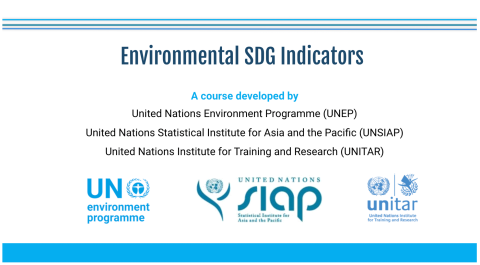
UNITAR Online Catalogue
Environmental SDG indicators

Accelerating SDG Implementation
Background
This e-learning course is a self-paced course with individual 10 modules developed by the United Nations Environment Programme (UNEP), the United Nations Statistical Institute for Asia and the Pacific (UNSIAP), and the United Nations Institute for Training and Research (UNITAR). In September 2015, the United Nations Sustainable Development Summit adopted an international framework to guide development efforts, entitled 'Transforming our world: the 2030 Agenda for sustainable development'. The Agenda is built around 17 Sustainable Development Goals (SDGs), divided into 169 targets, which are informed by 244 Indicators[1]. The importance of improving the availability of and access to data and statistics related to the environment was recognized through the adoption of a wide range of environmental SDG targets and indicators.
This course provides an overview of the importance of monitoring the environmental dimension of development, the linkage with existing statistical frameworks (FDES and SEEA), and how to use environment statistics in decision making. The modules will also provide a brief overview on all 25 SDG indicators under UNEP custodianship.
The course is also available in Russian and French.
[1] Currently 231 unique SDG indicators and 247 SDG indicators in total with repeated indicators.
Event Objectives
In particular, this e-learning course aims to build the capacity of countries – representatives of National Statistical Office (NSOs), Ministries of Environment and other stakeholders - to compile and use data on the environment-related SDGs for evidence-based decision-making and to promote cross-cutting data analysis to better understand the environmental dimension of development.
Learning Objectives
It is expected that, by the end of the course, participants will be better positioned to:
- Describe key concepts relevant for environmental monitoring and SDG indicators;
- Explain how respective environmental indicators are computed;
- Discuss key challenges the participants’ countries may be facing in compiling these indicators and actions that can be taken to address them.
Content and Structure
Module 1. Measuring the environment
Module 2. Linkage between the SDGs and the FDES and the SEEA
Module 3. Measuring waste in the SDGs
Module 4. Measuring the state of the oceans
Module 5. Land and water accounts and the SDGs
Module 6. Measuring material flows in the SDGs
Module 7. SCP interventions in the SDGs
Module 8. Policy coherence in the SDGs
Module 9. Measuring gender and environment
Module 10. Using environment statistics for national analysis and policy
Methodology
This e-learning course is developed in English and consists of ten modules. Each module is developed around the overall learning objectives, as well as second-level learning objectives specific to each module. Each module includes an interactive presentation complemented by a set of practice quizzes (“knowledge checks”/formative assessment); it is followed by an objective graded quiz (summative assessment) to be taken after completing the lesson to assess the knowledge and skills acquired. The interactive lessons within the module are implemented in a way that one needs to review all information on the slide prior to proceeding further. Once completed, the respective sections will be unlocked on the sidebar.
Each module can be regarded as a stand-alone module and taken individually. Modules 1, 8 and 10 comprise Learning Pathways for Policy Makers. Individual modules’ estimated net study time range between 1.5 – 2.5 hours depending on the length of the module and individual’s pace.
Targeted Audience
The target audience of the e-learning course is relevant staff from National Statistical Offices, Ministries of Environment, and also other civil servants and stakeholders that support broader national sustainable development monitoring and decision making, such as through the UN-led Common Country Analysis (CCA) and the government-led Sustainable Development Goals Voluntary National Reviews (VNR). The general public could also benefit by understanding what environment statistics are and how they can be utilized at the sub-national and national levels.